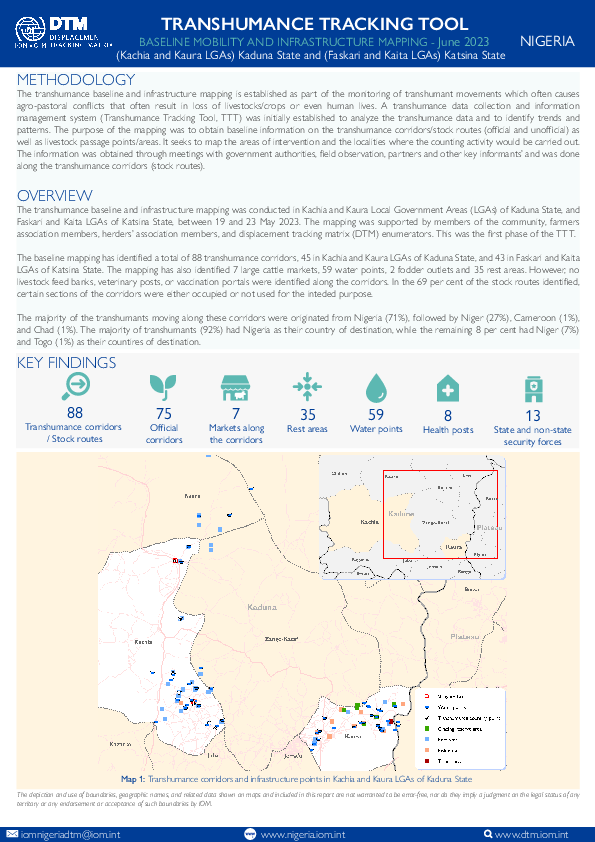-
Countries
-
Data and Analysis
-
Special Focus
-
Crisis Responses
Nigeria — Transhumance Tracking Tool Report — Baseline Mapping — Kachia and Kaura LGAs, Kaduna State and Faskari and Kaita LGAs, Katsina State (June 2023)

Contact
DTM Nigeria, iomnigeriadtm@iom.int
Language
English
Location
Nigeria
Period Covered
May 19 2023
May 23 2023
Activity
- Baseline Assessment
The transhumance baseline and infrastructure mapping is established as part of the monitoring of transhumant movements which often cause agro-pastoral conflicts that often result in loss of livestock/crops or even human lives. A transhumance data collection and information management system (Transhumance Tracking Tool, TTT) was initially established to analyze the transhumance data and to identify trends and patterns. The purpose of the mapping was to obtain baseline information on the transhumance corridors/stock routes (official and unofficial) as well as livestock passage points/areas. It seeks to map the areas of intervention and the localities where the counting activity would be carried out. The information was obtained through meetings with government authorities, field observation, partners and other key informants’ and was done along the transhumance corridors (stock routes).
The transhumance baseline and infrastructure mapping was conducted in Kachia and Kaura Local Government Areas (LGAs) of Kaduna State, and Faskari and Kaita LGAs of Katsina State, between 19 and 23 May 2023. The mapping was supported by members of the community, farmers association members, herders’ association members, and displacement tracking matrix (DTM) enumerators. This was the first phase of the TTT.
The baseline mapping has identified a total of 88 transhumance corridors, 45 in Kachia and Kaura LGAs of Kaduna State, and 43 in Faskari and Kaita LGAs of Katsina State. The mapping has also identified 7 large cattle markets, 59 water points, 2 fodder outlets and 35 rest areas. However, no livestock feed banks, veterinary posts, or vaccination portals were identified along the corridors. In the 69 per cent of the stock routes identified, certain sections of the corridors were either occupied or not used for the intended purpose.
The majority of the transhumants moving along these corridors were originated from Nigeria (71%), followed by Niger (27%), Cameroon (1%),
and Chad (1%). The majority of transhumants (92%) had Nigeria as their country of destination, while the remaining 8 per cent had Niger (7%)
and Togo (1%) as their countires of destination.
